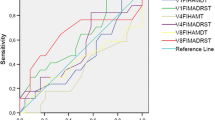Abstract
The present study developed new clinical cutoffs for the Beck Depression Inventory (BDI) and the Geriatric Depression Scale (GDS) with 59 older adult psychiatric outpatients. Maximum discrimination of a current major depressive episode resulted, with cutoff scores of 22 for the BDI and 16 for the GDS. Specifically, the following validity scores emerged for the BDI: sensitivity, 64%; specificity, 73%; positive predictive power, 75%; negative predictive power, 61%; and hit rate 68%. For the GDS the validity scores were as follows: sensitivity, 79%; specificity, 69%; positive predictive power, 77%; negative predictive power, 72%; and hit rate, 75%. Combined BDI and GDS scores did not result in improved prediction of a current major depressive episode as compared to the GDS alone. These results support the notion that the BDI and GDS are valid quick screening instruments in discriminating a current major depressive episode for older adult psychiatric outpatients.
Similar content being viewed by others
References
American Psychiatric Association (1987).Diagnostic and statistical manual of mental disorders (third edition-revised). Washington, D.C.: Author.
Beck, A. T., Ward, C. H., Mendelson, M., Mock, J., & Erbaugh, J. (1961). An inventory for measuring depression.Archives of General Psychiatry, 4, 53–63.
Beck, A. T., Steer, R. A., & Garbin, M. G. (1988). Psychometric properties of the Beck Depression Inventory: Twenty-five years of evaluation.Clinical Psychology Review, 8, 77–100.
Brink, T. L., Yesavage, J. A., Lum, O., Heersema, P., Adey, M., & Rose, T. L. (1981). Screening tests for geriatric depression.Clinical Gerontologist.1, 37–44.
Elwood, R. (1994). Psychological tests and clinical discriminations: Beginning to address the base rate problem.Clinical Psychology Review (in press).
Endicott, J., & Spitzer, R. (1978). A diagnostic interview: The schedule for affective disorders and schizophrenia.Archives of General Psychiatry, 35, 837–844.
Gallagher, D., Nies, G., & Thompson, L. (1982). Reliability of the Beck Depression Inventory with older adults.Journal of Consulting and Clinical Psychology, 50, 152–153.
Gallagher, D., Breckenridge, J., Steinmetz, J., & Thompson, L. (1983). The Beck Depression Inventory and Research Diagnostic Criteria: Congruence in an older adult population.Journal of Consulting and Clinical Psychology, 51, 945–946.
Hollingshead, A. B. (1975).Four-factor index of social status. Unpublished manuscript. New Haven, CT: Department of Sociology, Yale University.
Hyer, L., & Blount, J. (1984). Concurrent and discriminant validities of the Geriatric Depression Scale with older psychiatric inpatients.Psychological Reports, 54, 611–616.
Norris, J., Gallagher, D., Wilson, A., & Winograd, C. (1987). Assessment of depression in geriatric medical outpatients: The validity of two screening measures.Journal of the American Geriatric Society, 35, 989–995.
Olin, J. T., Schneider, L. S., Eaton, E. M., Zemansky, M. F., & Pollock, V. E. (1992). The Geriatric Depression Scale and the Beck Depression Inventory as screening instruments in an older adult outpatient population.Psychological Assessment, 4, 190–192.
Pollock, V., & Schneider, L. (1990). Topographic quantitative EEG in elderly subjects with major depression.Psychophysiology, 27, 438–444.
Rapp, S. R., Parisi, S. A., Walsh, D. A., & Wallace, C. E. (1988). Detecting depression in elderly medical inpatients.Journal of Consulting and Clinical Psychology, 56, 509–513.
Segal, D., Hersen, M., Van Hasselt, V. B., Kabacoff, R., & Roth, L. (1993). Reliability of diagnosis in older psychiatric patients using the structured clinical interview for DSM-III-R.Journal of Psychopathology and Behavioral Assessment, 15, 347–356.
Spitzer, R., Williams, J., Gibbon, M., & First, M. (1988).Structured clinical interview for DSM III R-Patient edition. New York: Biometrics Research Department, New York State Psychiatric Institute.
Taylor, E. B., & Klein, D. N. (1989). Assessing recovery in depression: Validity of symptom inventories.Cognitive Therapy and Research, 13, 1–8.
Yesavage, J. A., Brink, T. L., Rose, T. L., Lum, O., Huang, V., Adey, M., & Leirer, V. (1983). Development and validation of a geriatric depression screening scale: A preliminary report.Journal of Psychiatric Research, 17, 37–49.
Author information
Authors and Affiliations
Rights and permissions
About this article
Cite this article
Kogan, E.S., Kabacoff, R.I., Hersen, M. et al. Clinical cutoffs for the beck Depression inventory and the Geriatric Depression scale with older adult psychiatric outpatients. J Psychopathol Behav Assess 16, 233–242 (1994). https://doi.org/10.1007/BF02229210
Accepted:
Issue Date:
DOI: https://doi.org/10.1007/BF02229210



